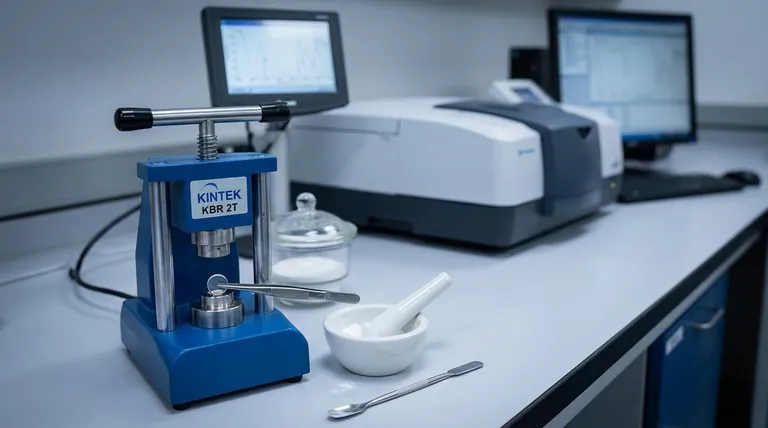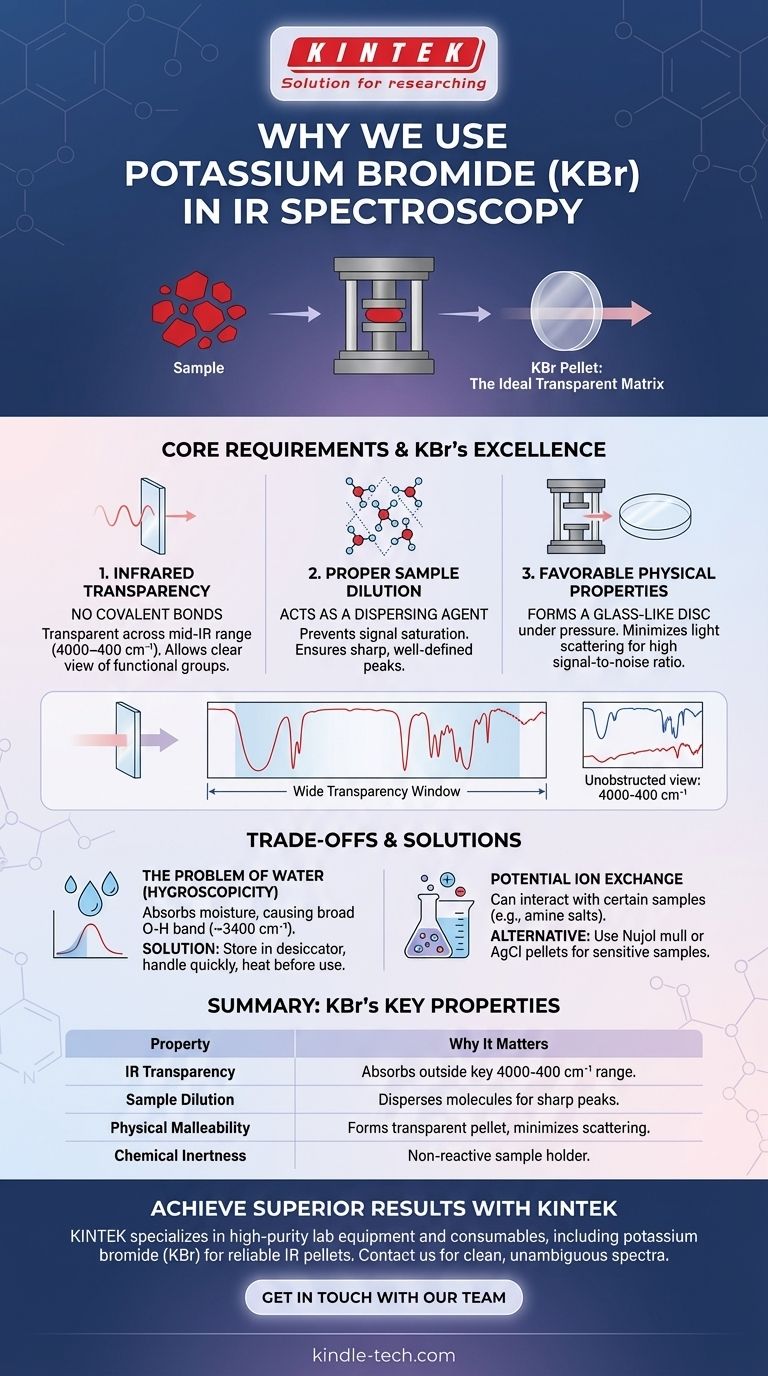要するに、IR分光法で臭化カリウム(KBr)を使用するのは、最も有用な周波数範囲全体で赤外線に対して透明であるためです。また、分析のために固体サンプルを保持できる、薄く均一なペレットにプレスするための理想的な物理的特性も備えており、測定を妨げることがありません。
IR分光法で固体サンプルを分析する際の中心的な課題は、光がホルダー材料によって散乱または吸収されることなく通過できるようにサンプルを調製することです。KBrは理想的な固体状態の「溶媒」として機能し、サンプル分子を分離してクリーンで妨げられないスペクトルを可能にする透明なマトリックスを作成します。
サンプルマトリックスの基本的な要件
固体の高品質な赤外線スペクトルを得るためには、サンプルを保持するために使用される材料、すなわちマトリックスが、いくつかの厳格な基準を満たす必要があります。マトリックスの選択は、分光計そのものと同じくらい重要です。
要件1:赤外線透明性
吸収分光法の基本原理は、サンプルによって吸収された光を測定することであり、容器によって吸収された光を測定することではありません。
理想的なマトリックスは、サンプルと同じエネルギー範囲で振動する(したがって吸収する)分子結合を持っていてはなりません。KBrは単純なイオン性塩(K⁺Br⁻)であるため、共有結合を持っていません。そのイオン格子振動は非常に低い周波数で発生し、官能基を同定する標準的な近赤外域(4000~400 cm⁻¹)よりもはるかに外側にあります。
要件2:適切なサンプル希釈
液体状態の分析と同様に、濃度が高すぎるサンプルは劣悪なスペクトルをもたらします。
高濃度はピークを過度に広げ、頂部が平坦になる(シグナル飽和と呼ばれる現象)ため、解釈が不可能になります。KBr粉末は分散剤として機能し、ペレット内でサンプル分子同士を分離します。これにより、IR光線が分離された分子と相互作用し、シャープで明確なピークが生成されることが保証されます。
要件3:好ましい物理的特性
マトリックスは、曇りではなく、透明な固体ディスクを形成する必要があります。曇りや不完全性があると、IR光線が散乱され、シグナル対ノイズ比が低下し、スペクトルのベースラインが歪みます。
KBrは比較的柔らかい結晶性材料です。高圧下では、その結晶構造が流れ、変形して均一で透明なガラス状のディスクを形成します。より硬い材料は、破砕するか適切に融合せず、光を散乱させる不透明なペレットになる可能性があります。

臭化カリウム(KBr)が優れている理由
KBrは固体IRマトリックスの主要な要件をすべて満たしており、この技術の標準的な選択肢となっています。
広い透明ウィンドウ
KBrは、遠紫外から近赤外全体にわたって透明であり、カットオフは約400 cm⁻¹です。これにより、化合物の同定に不可欠な、全官能基領域(4000~1500 cm⁻¹)と複雑な「フィンガープリント領域」(1500~400 cm⁻¹)を遮るものなく観察できます。
ペレット作成に理想的な展延性
KBrの柔らかさにより、サンプルと混ぜて微粉末に粉砕することができ、均一な混合が保証されます。ダイ(金型)でプレスすると、光の散乱を最小限に抑えて固体ペレットに融合し、スペクトルの品質を最大化します。
一般的な化学的不活性
ほとんどの有機化合物および無機化合物に対して、KBrは非反応性です。それは単にサンプルをIR光線の経路に保持するための不活性なマトリックスとして機能します。
トレードオフと一般的な落とし穴の理解
KBrは標準ですが、限界がないわけではありません。これらを理解することは、一般的なエラーを回避し、結果を正しく解釈するための鍵となります。
水の懸念:吸湿性
KBrの最も重要な欠点は、吸湿性があることです。つまり、大気中の湿気を容易に吸収します。
この水はスペクトルに現れ、約3400 cm⁻¹を中心とする非常に広い吸収帯(O-H伸縮振動)と、約1640 cm⁻¹を中心とするより小さくシャープな帯(H-O-H曲げ振動)を生成します。これを避けるためには、KBrをデシケーターに保管し、迅速に取り扱う必要があります。多くの場合、使用前にKBrをオーブンで加熱して吸収した水分を追い出す必要があります。
イオン交換の可能性
KBrはイオン性塩であるため、特定の種類のサンプルと相互作用することがあります。たとえば、アミンの塩酸塩(R-NH₃⁺Cl⁻)を分析する場合、KBrペレットからの臭化物イオンが塩化物イオンと交換し、サンプルの真の構造やスペクトルが変化することがあります。
KBrペレットを使用すべきでない場合
サンプルが湿気に非常に敏感である場合、微粉末に粉砕できない場合、またはKBrと反応する場合は、代替方法が必要です。最も一般的な代替方法は**ヌジョールマル(Nujol mull)**であり、固体を有機鉱物油(ヌジョール)と粉砕してペーストを形成します。ただし、この方法では鉱物油自体の干渉ピークが発生します。
目的に合った正しい選択をする
信頼できるデータを取得するためには、適切なサンプル調製技術を選択することが不可欠です。
- 主な焦点が一般的な固体サンプルである場合: KBrペレットは、水分汚染を避けるために材料を適切に取り扱う限り、高品質で全範囲のスペクトルを得るためのゴールドスタンダードです。
- サンプルが湿気や圧力に敏感な場合: ヌジョールマルを調製することを検討してください。ただし、鉱物油に由来する既知のC-H吸収帯を差し引くか無視する準備が必要です。
- サンプルがハロゲン化物交換を起こしやすいイオン性塩である場合: KBrの使用には注意が必要です。ヌジョールマル、または塩化銀(AgCl)で作られた特殊なペレットの方が信頼できる選択肢となる場合があります。
結局のところ、サンプルマトリックスの特性を理解することは、クリーンで信頼できる赤外線スペクトルを取得するための最初のステップです。
要約表:
| 特性 | IR分光法で重要である理由 |
|---|---|
| IR透明性 | 共有結合を持たないため、主要な4000~400 cm⁻¹範囲外で吸収し、サンプルのスペクトルを明確に観察できる。 |
| サンプル希釈 | サンプル分子を分散させ、シグナル飽和を防ぎ、正確な分析のためにシャープで明確なピークを保証する。 |
| 物理的展延性 | 高圧で硬く透明なペレットにプレスされ、光の散乱を最小限に抑え、シグナル対ノイズ比を最大化する。 |
| 化学的不活性 | ほとんどの有機および無機化合物と一般的に非反応性であり、受動的なサンプルホルダーとして機能する。 |
実験室で優れた結果を達成する準備はできましたか?
KINTEKは、信頼性の高いIRペレットの作成に最適な臭化カリウム(KBr)を含む、高純度の実験用機器および消耗品の製造を専門としています。当社の製品は、固体サンプルのクリーンで曖昧さのないスペクトルを取得し、研究と品質管理の正確性を保証するように設計されています。
今すぐお問い合わせいただき、お客様の実験室のニーズについてご相談ください。当社の専門家が、正確で効率的な分光法のための適切な材料の選択をお手伝いします。
ビジュアルガイド

関連製品
- kbrペレットプレス 2t
- ラボラトリー油圧プレス 分割式電動ラボペレットプレス
- ラボ用自動油圧ペレットプレス機
- 実験室用油圧ペレットプレス(XRF KBR FTIR実験室用途)
- ラボ用油圧ペレットプレス実験装置



















